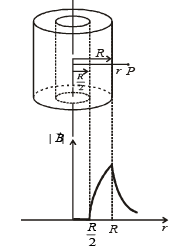JEE Advanced (Single Correct MCQs): Moving Charges & Magnetism - JEE MCQ
24 Questions MCQ Test Chapter-wise Tests for JEE Main & Advanced - JEE Advanced (Single Correct MCQs): Moving Charges & Magnetism
A conducting circular loop of radius r carries a constant current i. It is placed in a uniform magnetic field  such that
such that  is perpendicular to the plane of the loop. The magnetic force acting on the loop is
is perpendicular to the plane of the loop. The magnetic force acting on the loop is
A battery is connected between two points A and B on the circumference of a uniform conducting ring of radius r and resistance R. One of the arcs AB of the ring subtends an angle q at the centre.The value of the magnetic induction at the centre due to the current in the ring is
A proton, a deuteron and an α - particle having the same kinetic energy are moving in circular trajectories in a constant magnetic field. If rp, rd, and ra denote respectively the radii of the trajectories of these particles, then
A circular loop of radius R, carrying current I, lies in x-y plane with its centre at origin. The total magnetic flux through x-y plane is
A charged particle is released from rest in a region of steady and uniform electric and magnetic fields which are parallel to each other. The particle will move in a
A particle of charge q and mass m moves in a circular orbit of radius r with angular speed ω . The ratio of the magnitude of its magnetic moment to that of its angular momentum depen ds on
Two long parallel wires are at a distance 2d apart. They carry steady equal currents flowing out of the plane of the paper, as shown. The variation of the magnetic field B along the line XX' is given by
An infinitely long conductor PQR is bent to form a right angle as shown in Figure. A current I flows through PQR. The magnetic field due to this current at the point M is H1. Now, another infinitely long straight conductor QS is connected at Q so that current is I/2 in QR as well as in QS, the current in PQ remaining unchanged. The magnetic field at M is now H2. The ratio H1/H2 is given by

An ionized gas contains both positive and negative ions. If it is subjected simultaneously to an electric field along the +x-direction and a magnetic field along the +z-direction, then
A non-planar loop of conducting wire carrying a current I is placed as shown in the figure. Each of the straight sections of the loop is of length 2a. The magnetic field due to this loop at the point P(a, 0, a) points in the direction
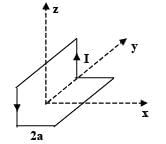
Two particles A and B of masses mA and mB respectively and having the same charge are moving in a plane. A uniform magnetic field exists perpendicular to this plane. The speeds of the particles are vA and vB respectively and the trajectories are as shown in the figure. Then

A coil having N turns is wound tightly in the form of a spiral with inner and outer radii a and b respectively. When a current I passes through the coil, the magnetic field at the center is
A particle of mass m and charge q moves with a constant velocity v along the positive x-direction. It enters a region containing a uniform magnetic field B directed along the negative z-direction, extending from x = a to x = b. The minimum value of v required so that the particle can just enter the region x > b is
A long straight wire along the Z-axis carries a current I in the negative Z-direction. The magnetic vector field at a point having coordinates (x, y) in the Z = 0 plane is
The magnetic field lines due to a bar magnet are correctly shown in
For a positively charged particle moving in a x-y plane initially along the x-axis, there is a sudden change in its path due to the presence of electric and/or magnetic fields beyond P.
The curved path is shown in the x-y plane and is found to be non-circular. Which one of the following combinations is possible?
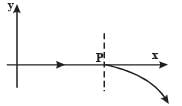
A conducting loop carrying a current I is placed in a uniform magnetic field pointing into the plane of the paper as shown. The loop will have a tendency to

A current carrying loop is placed in a uniform magnetic field in four different orientations, I, II, III & IV arrange them in the decreasing order of Potential Energy




An electron travelling with a speed u along th e positive xaxis enters into a region of magnetic field where B = –B0 kˆ (x > 0). It comes out of the region with speed v then

A magnetic field  exists in the region a < x < 2a, and
exists in the region a < x < 2a, and  , in the region 2a < x < 3a, where B0 is a positive constant. A positive point charge moving with a velocity
, in the region 2a < x < 3a, where B0 is a positive constant. A positive point charge moving with a velocity  , where v0 is a positive constant, enters the magnetic field at x = a. The trajectory of the charge in this region can be like
, where v0 is a positive constant, enters the magnetic field at x = a. The trajectory of the charge in this region can be like
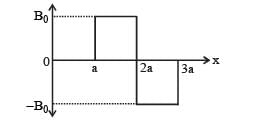
A thin flexible wire of length L is connected to two adjacent fixed points and carries a current I in the clockwise direction, as shown in the figure. When the system is put in a uniform magnetic field of strength B going into the plane of the paper, the wire takes the shape of a circle. The tension in the wire is

A long insulated copper wire is closely wound as a spiral of ‘N’ turns. The spiral has inner radius ‘a’ and outer radius ‘b’. The spiral lies in the XY plane and a steady current ‘I’ flows through the wire. The Z-component of the magnetic field at the centre of the spiral is

A loop carrying current I lies in the x-y plane as shown in the figure. The unit vector kˆ is coming out of the plane of the paper. The magnetic moment of the current loop is
An infinitely long hollow conducting cylinder with inner radius R/2 and outer radius R carries a uniform current density along its length. The magnitude of the magnetic field, as a function of the radial distance r from the axis is best represented by
|
446 docs|930 tests
|


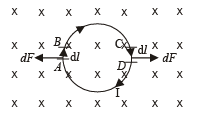














 ) is in upward direction but magnetic field at C due to B is in downward direction.
) is in upward direction but magnetic field at C due to B is in downward direction.

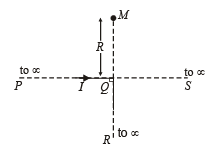






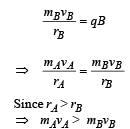
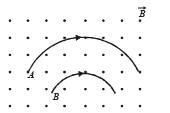
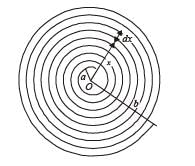





 where 'R' is its radius of curvature inside magnetic field,
where 'R' is its radius of curvature inside magnetic field,







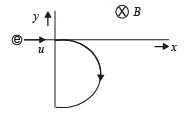
 to get the instantaneous direction of force at x = a and x = 2a.
to get the instantaneous direction of force at x = a and x = 2a.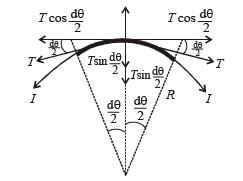


 cancel out and
cancel out and add up to balance FB.
add up to balance FB.



 the direction is towards positive z-axis.
the direction is towards positive z-axis.


